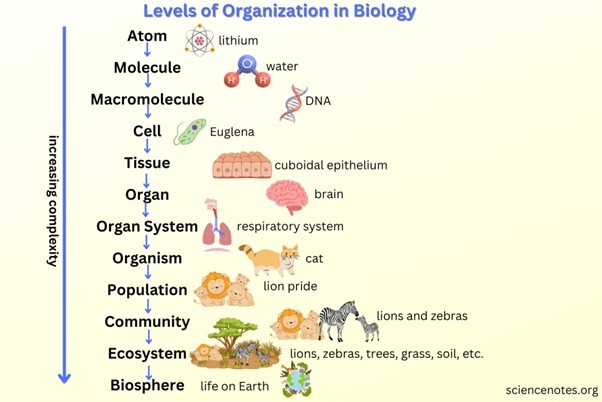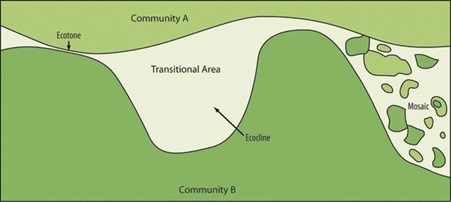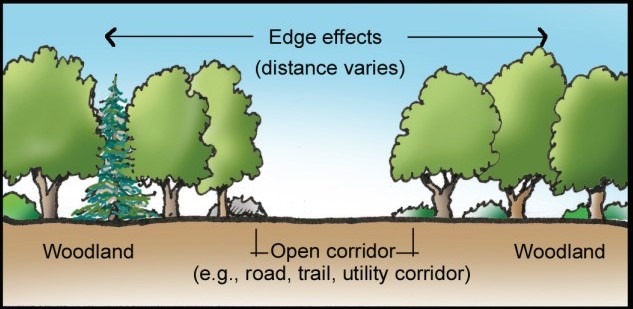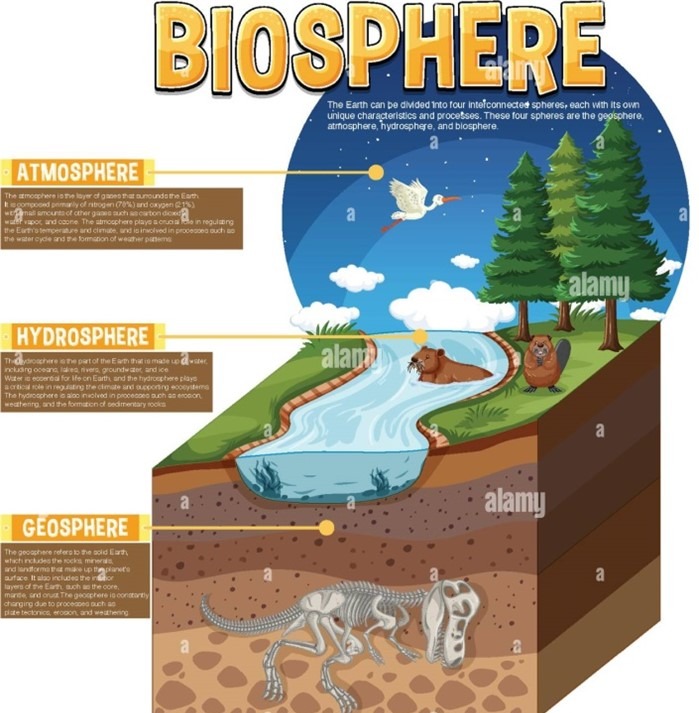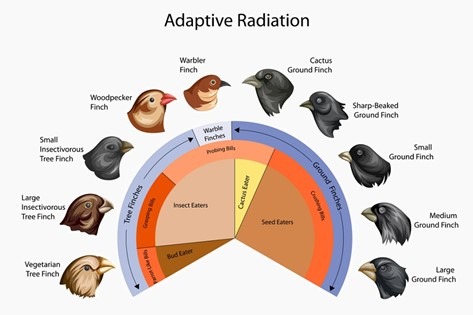Ecology – Principles and Organizations
Ecology
Ecology is a branch of biology that focuses on the study of interactions between living organisms and their physical environment. It examines how different species coexist, compete, and depend on each other for survival, as well as how they respond to environmental factors such as climate, water, soil, and human activities. Ecology plays a crucial role in understanding biodiversity, ecosystem dynamics, conservation efforts, and the impact of human actions on natural habitats.
Levels of Organizations in Ecology:
Ecology is the scientific study of the interactions and relationships among living organisms and their environment at various levels of biological organization. It explores how individuals interact with their surroundings, how organisms adapt and survive, and how populations grow and change over time. Additionally, ecology examines the dynamics of communities, the structure and function of ecosystems, the characteristics of biomes, and the interconnectedness of the biosphere as a whole. By understanding these complex relationships, ecologists can assess biodiversity, ecosystem health, and the impact of environmental changes, ultimately contributing to conservation and sustainability efforts worldwide.
Individual and Species:
An organism is an individual living entity capable of carrying out essential life processes independently. Organisms can range from microscopic bacteria and single-celled protists to complex multicellular beings such as plants, animals, and humans. Each organism interacts with its environment, responding to stimuli, obtaining energy, reproducing, and maintaining homeostasis to sustain life.
A species, on the other hand, is a distinct group of organisms that share common characteristics, genetic similarities, and the ability to interbreed, ensuring the continuation of genetic material across generations. Species represent the fundamental unit of biological classification and are vital in understanding biodiversity and evolutionary relationships. Scientists identify species using a standardized system called binomial nomenclature, in which each species is assigned a two-part Latin name—for example, Homo sapiens for humans. This classification system helps biologists categorize and study the immense diversity of life on Earth, providing insights into evolutionary history, ecological roles, and conservation efforts.
Population:
A population is defined as a group of interbreeding organisms belonging to the same species that coexist within a specific geographic region at a particular time. Populations are dynamic and can fluctuate based on various environmental and biological factors. The population growth rate is influenced by births and immigration, which contribute to an increase in population size, while deaths and emigration result in population decline. Understanding population dynamics is crucial in ecological studies, conservation efforts, and wildlife management.
Assessing Population Density in Mobile Species
For species that are expansive and highly mobile, such as tigers, leopards, lions, and deer, determining population density can be challenging. One effective method for estimating their numbers in the wild involves analyzing pugmarks—the footprints left by these animals in their natural habitats.
The Importance of Pugmark Analysis in Ecology
Pugmark examination is a reliable and widely used technique that provides critical ecological insights, including:
- Species Identification: By studying pugmarks, researchers can determine which species inhabit a particular region, helping in biodiversity assessments.
- Individual Recognition: Each animal has a unique pugmark pattern, much like a human fingerprint. This allows researchers to identify specific individuals within a population.
- Population Estimation: This method plays a crucial role in estimating the population size of large felids, such as tigers and lions, by tracking and analyzing their footprints over a designated area.
- Sex and Age Classification: Pugmark analysis helps in distinguishing between male and female individuals based on footprint size and structure. Additionally, it aids in categorizing animals as juveniles or adults, providing essential data for studying population demographics.
Significance in Wildlife Conservation
Understanding population trends and movement patterns through pugmark analysis contributes significantly to wildlife conservation. It assists conservationists in devising strategies for habitat preservation, mitigating human-wildlife conflicts, and ensuring the long-term survival of endangered species. With advancements in technology, pugmark tracking is now complemented by camera traps, genetic analysis, and satellite monitoring, further enhancing the accuracy of wildlife population assessments.
By employing such ecological methodologies, researchers and conservationists can make informed decisions to protect vulnerable species and maintain ecological balance in various ecosystems worldwide.
Community:
In ecology, a community refers to a group of interacting plant, animal, and microbial species that coexist within a specific environment. Communities are classified based on the dominant type of vegetation that defines their structure and composition. For example, a grassland community is primarily characterized by the abundance of grasses, but it may also include a diverse array of herbs, shrubs, trees, and other plant species that contribute to the overall ecosystem.
Communities play a fundamental role in ecosystem stability, biodiversity, and ecological interactions. They can be categorized into different types based on their size, dependence, and stability.
Types of Ecological Communities
1. Major Communities
Major communities are large, self-sustaining ecosystems that function independently and derive their energy primarily from the sun. These communities encompass a diverse range of plant and animal species and often cover extensive geographical areas. They serve as the backbone of global ecosystems, supporting vast biodiversity and ecological processes.
Examples of Major Communities:
- Tropical evergreen forests – Dense forests with high rainfall and year-round greenery, home to diverse flora and fauna.
- Coral reef ecosystems – Marine communities dominated by corals, supporting a variety of marine life.
- Desert ecosystems – Arid regions characterized by drought-resistant plants and specially adapted animals.
2. Minor Communities
Minor communities, often referred to as societies, are smaller ecological groupings that depend on neighboring communities for survival. These communities do not function independently and often exist within a larger ecological system. They play a crucial role in ecosystem diversity by contributing to nutrient cycling, habitat formation, and species interactions.
Examples of Minor Communities:
- A mat of lichen on a cow dung pad – A small-scale biological community where lichens thrive on decomposing organic material.
- Moss patches on tree bark – Tiny plant communities that depend on the presence of trees for support and moisture.
- Algal growth in freshwater ponds – A temporary, dependent community contributing to the aquatic food web.
3. Stable Communities
A stable community is one that exhibits minimal variation in productivity over time, maintaining ecological balance despite environmental fluctuations. These communities are resilient, with well-established food chains, efficient nutrient cycling, and self-regulating mechanisms that promote sustainability.
Characteristics of Stable Communities:
- High biodiversity, ensuring ecosystem resilience.
- Efficient energy flow and nutrient cycling.
- Adaptability to gradual environmental changes without major disruptions.
- Examples: Old-growth forests, undisturbed coral reefs, and mature wetlands that have maintained ecological stability over long periods.
Significance of Community Classification in Ecology
Understanding the classification of ecological communities is essential for conservation efforts, habitat restoration, and biodiversity management. By analyzing the structure and function of different communities, ecologists can develop strategies to protect endangered ecosystems, mitigate climate change impacts, and ensure the sustainability of natural habitats.
As human activities continue to influence ecosystems worldwide, the study of ecological communities plays a crucial role in fostering environmental awareness, sustainable land use, and biodiversity conservation for future generations.
Ecosystem:
In ecological systems, organisms continuously interact with each other and their environment, forming complex networks of relationships. These interactions facilitate the exchange of energy and cycling of essential elements, such as carbon, nitrogen, and phosphorus, which sustain life on Earth. The dynamic balance within ecosystems ensures that resources are efficiently used, waste is recycled, and biodiversity is maintained.
A crucial concept in ecology that defines how species function within their environment is the ecological niche.
Ecological Niche: The Functional Role of a Species in an Ecosystem
An ecological niche refers to the specific functional role or position that a species occupies within an ecosystem. It encompasses all aspects of a species’ interaction with its surroundings, including its habitat, behavior, diet, and adaptations. No two species can occupy the exact same niche within a stable ecosystem, as competition for identical resources would eventually lead to competitive exclusion or adaptation.
In nature, multiple species may share the same habitat, but they fulfill distinct roles within the ecosystem, ensuring coexistence and ecological balance.
Types of Ecological Niches
To better understand how species function within their environment, ecological niches can be classified into different categories:
1. Habitat Niche – The specific living space or physical area where a species resides.
- Example: A woodpecker’s habitat niche is tree trunks, whereas a fish’s habitat niche is freshwater lakes or oceans.
2. Food Niche – The dietary habits of a species, including what it consumes, how it decomposes organic matter, and its competition for resources.
- Example: Carnivores like lions prey on herbivores, while decomposers like fungi break down organic material into nutrients.
3. Reproductive Niche – The timing, method, and conditions necessary for a species to reproduce and sustain its population.
- Example: Some insects reproduce in specific seasons, while amphibians require aquatic environments for egg-laying.
4. Physical and Chemical Niche – The environmental factors that influence a species’ survival, such as temperature range, terrain, humidity, and pH levels.
- Example: Cacti thrive in arid, high-temperature environments, whereas mosses prefer moist, shaded regions with high humidity.
Significance of Understanding Ecological Niches
The study of ecological niches is vital for:
- Biodiversity Conservation – Identifying the roles species play in their environment helps conservationists protect vulnerable species and their habitats.
- Ecosystem Stability – Understanding niche differentiation reduces competition and promotes species coexistence, contributing to a balanced ecosystem.
- Sustainable Resource Management – Insights into species interactions help in developing sustainable agricultural and forestry practices.
- Climate Change Adaptation – Analyzing ecological niches allows scientists to predict how species will respond to environmental changes, aiding in habitat restoration and climate resilience efforts.
Difference between Niche and Habitat:
Niche :A niche is a distinct ecological role that each species occupies within an ecosystem. Even in shared habitats, no two species can have identical niches due to competition, which prevents complete overlap. This principle, known as the competitive exclusion principle, ensures that organisms specialize in different aspects of resource utilization to coexist. For instance, various insect species may inhabit the same plant but avoid direct competition by feeding on different parts—some consuming leaves, others burrowing into stems, and some extracting nectar from flowers. This specialization allows species to thrive within the same environment while maintaining biodiversity.
Biome: Distinct Ecosystem Classifications
A biome is a large-scale ecological classification characterized by distinct climatic conditions, dominant vegetation, specific animal communities, and unique soil properties. These biomes serve as the foundation for the planet’s biodiversity, supporting life in diverse ways.
The primary factors that define and differentiate biomes include variations in temperature and precipitation patterns. These climatic elements influence plant growth, which in turn affects the animal species that depend on them.
Major Terrestrial Biomes:
1. Tropical Rainforests – Warm temperatures and high rainfall support dense forests and immense biodiversity.
2. Deserts – Arid landscapes with extreme temperature variations and drought-adapted plants and animals.
3. Grasslands – Open landscapes with seasonal precipitation, home to grazing herbivores and predators.
4. Temperate Forests – Deciduous or evergreen forests found in regions with moderate climates.
5. Tundra – Cold, treeless biomes with permafrost, where only hardy, low-growing vegetation survives.
6. Taiga (Boreal Forests) – Coniferous forests with long winters and short growing seasons.
Each biome supports a unique community of organisms that have evolved to adapt to its specific environmental conditions.
Ecotone: The Transition Between Ecosystems
An ecotone is a transitional zone where two distinct ecosystems meet and merge, creating a unique environment that incorporates characteristics from both adjacent biomes. Examples include:
- Mangroves – A convergence of marine and terrestrial ecosystems, where salt-tolerant trees create a vital habitat for aquatic and land species.
- Grasslands – A transition between forests and deserts, supporting herbivores and diverse plant species.
- Estuaries – Where freshwater rivers meet saltwater seas, creating highly productive and nutrient-rich environments.
- Marshlands – Wetland regions that exist between dry land and aquatic ecosystems, supporting amphibians, waterfowl, and specialized vegetation.
Characteristics of Ecotones:
- They may be narrow or wide, depending on the degree of environmental blending between adjacent ecosystems.
- Conditions in an ecotone are intermediate, often leading to a zone of tension where species from both neighboring ecosystems interact.
- Species abundance typically declines as one moves away from the central zone of the ecotone and into a more defined ecosystem.
- Many ecotones contain unique organisms that are not found in the adjacent ecosystems, making them areas of high biodiversity.
Ecological Importance of Ecotones:
Ecotones tend to exhibit higher productivity than the surrounding ecosystems because they incorporate species and resources from both environments. This rich biodiversity results in:
- Increased food availability for various organisms.
- Greater habitat diversity, attracting a mix of species from both ecosystems.
- Enhanced ecosystem resilience, as species in ecotones often develop adaptive traits suited for variable conditions.
Ecocline:
An ecocline is a gradual transition zone between two or more ecosystems, where changes occur progressively rather than abruptly. Unlike ecotones, which have relatively defined boundaries between ecosystems, an ecocline forms along an environmental gradient, where conditions shift gradually over space.
Ecoclines can be observed in various natural settings, where factors such as altitude, temperature, salinity, or depth drive continuous ecological changes. These gradients influence the types of organisms that can survive and thrive at different points along the transition.
Types of Ecoclines:
Ecoclines are categorized based on the dominant environmental factor shaping the transition:
1.0 Altitudinal Ecocline – Found in mountainous regions, where increasing elevation leads to gradual changes in vegetation, temperature, and oxygen levels. For example:
- Lowland rainforests transition into montane forests, then into alpine meadows, and finally into barren, ice-covered peaks.
2. Thermocline (Temperature Gradient) – Occurs in large water bodies, such as oceans and lakes, where water temperature decreases with depth. This temperature gradient affects the distribution of marine life, influencing species that thrive in warm surface waters versus those adapted to colder, deeper layers.
3. Halocline (Salinity Gradient) – Seen in aquatic ecosystems where freshwater and saltwater mix, such as estuaries. Salinity levels gradually increase from river mouths toward the open sea, creating distinct zones that support different types of aquatic organisms.
4. Depth-Related Ecocline – Common in deep oceans and lakes, where pressure, light availability, and nutrient levels change progressively with depth. This results in distinct biological zones, from sunlit epipelagic waters to the dark abyssal depths, each supporting specialized life forms.
5. Soil Moisture Gradient – Found in terrestrial environments where changes in water availability shape vegetation distribution. Examples include transitions from wetlands to drylands or from riverbanks to arid regions, where plant species gradually shift from water-dependent varieties to drought-tolerant ones.
Significance of Ecoclines:
- Biodiversity Hotspots – Ecoclines support a wide range of species that are adapted to varying conditions along the gradient.
- Adaptive Evolution – Organisms living in ecocline regions often develop specialized traits to survive the changing conditions.
- Indicator of Environmental Change – Ecoclines are sensitive to climate fluctuations, pollution, and habitat alterations, making them important for ecological monitoring.
- Influence on Species Migration – Many migratory species rely on ecoclines to navigate and find suitable habitats, as these zones provide resources and favorable conditions throughout their journey.
Because ecoclines lack clear boundaries, they are crucial for understanding gradual ecological changes and how organisms interact with shifting environmental factors. These transition zones play a key role in maintaining ecological balance and fostering diverse ecosystems across landscapes.
Edge Effect and Edge Species:
The edge effect is an ecological phenomenon observed in ecotones, the transition zones between two distinct ecosystems. These regions exhibit heightened biodiversity and population density, resulting from the unique combination of environmental conditions, species interactions, and resource availability. Because ecotones integrate characteristics from adjacent ecosystems, they support a greater variety of species than either of the neighboring habitats alone.
Why Does the Edge Effect Occur?
The increased biodiversity and population density in ecotones arise due to several ecological factors:
1. Diverse Resources: Ecotones provide access to resources from both adjoining ecosystems, allowing species to exploit a wider range of food sources, nesting sites, and shelter.
2. Species Overlap: Organisms from both bordering ecosystems often venture into the ecotone, leading to a greater number of species coexisting in the same space.
3. Microhabitats: The variation in environmental conditions creates microhabitats that cater to a broad range of species, including generalists and specialists.
4. Increased Interactions: The edge effect enhances species interactions, including predation, competition, and symbiotic relationships, which influence population dynamics.
Edge Species: Organisms Thriving in Ecotones
Species that are specially adapted to thrive in transitional zones are known as edge species. These organisms benefit from the rich resources and unique conditions of ecotones, often showing higher population densities in these areas compared to core ecosystems.
In terrestrial ecosystems, one of the most notable examples of the edge effect is seen in bird populations. For instance, in forest-desert ecotones, bird density tends to be significantly higher than in either the dense forest or arid desert alone. The presence of both trees and open land provides an ideal habitat for a mix of forest-dwelling and open-land bird species. Similarly, deer, rodents, and certain insect species also flourish in ecotone regions, taking advantage of the overlapping ecological conditions.
Significance of the Edge Effect
- Enhances Biodiversity: Ecotones often serve as biodiversity hotspots, supporting a greater variety of species.
- Affects Wildlife Conservation: The edge effect can both benefit and challenge conservation efforts. While some species thrive in ecotones, others—particularly deep-forest or deep-desert species—may struggle with increased competition and predation.
- Influences Land Use and Agriculture: Human-made edges, such as those created by deforestation or urbanization, can inadvertently increase certain species’ populations while disrupting others. This knowledge is essential for managing wildlife habitats and ecological restoration projects.
- Impacts Predator-Prey Dynamics: The influx of species in an ecotone can alter food webs, influencing predator-prey relationships and competition levels.
Biosphere:
The biosphere is the sum total of all living organisms on Earth, encompassing life forms that thrive in a variety of environments, from the deepest oceans to the highest mountains. It includes interactions between living beings and the physical components of the planet, such as the lithosphere (land), hydrosphere (water bodies), and atmosphere (air). Additionally, the biosphere incorporates dead organic matter, which plays a crucial role in nutrient cycling and ecosystem balance.
Components of the Biosphere
The biosphere is a complex system that integrates biotic (living) and abiotic (non-living) elements:
- Lithosphere – The solid outer layer of Earth, home to terrestrial ecosystems, including forests, grasslands, deserts, and tundras.
- Hydrosphere – Encompasses all water bodies, such as oceans, lakes, rivers, and wetlands, where aquatic life thrives.
- Atmosphere – The layer of gases surrounding the planet, supporting airborne microorganisms, birds, and the processes essential for sustaining life, such as oxygen exchange and photosynthesis.
- Organic Matter – Dead plant and animal material, which decomposes to recycle nutrients back into the environment, sustaining food webs and soil fertility.
Limits of the Biosphere: Inhospitable Extremes
Although the biosphere is vast, it does not extend uniformly across the planet. Life is largely absent or extremely scarce in extreme environments where conditions are too harsh to support active metabolism. These inhospitable zones include:
- Polar Ice Caps – Freezing temperatures and a lack of liquid water make survival nearly impossible for most life forms. Only extremophiles, such as cold-adapted microbes, persist.
- High Mountain Peaks – Reduced oxygen levels, extreme cold, and intense UV radiation at elevations above 8,000 meters limit the presence of complex life forms.
- Deep Ocean Trenches – Beyond the reach of sunlight, immense water pressure and low temperatures restrict life primarily to specialized deep-sea organisms, such as bacteria near hydrothermal vents.
- Arid Deserts – Some desert regions, like the Atacama Desert, experience almost no precipitation, creating conditions too harsh for most living organisms.
Dormant Life Beyond Habitability
While active life is largely absent in extreme environments, certain life forms exhibit remarkable survival strategies. Metabolically inactive spores of fungi and bacteria have been found at altitudes exceeding 8,000 meters, including in the stratosphere. These spores remain in a dormant state, capable of reactivating under favorable conditions. Such adaptations demonstrate the resilience of life and its potential ability to exist beyond Earth’s biosphere, possibly in extraterrestrial environments.
Significance of the Biosphere
- Foundation of Earth’s Ecosystems – The biosphere regulates the flow of energy and nutrients, sustaining all forms of life.
- Climate Regulation – Living organisms, particularly plants and oceans, play a vital role in balancing atmospheric gases, influencing weather patterns and global climate.
- Biodiversity and Evolution – The biosphere fosters immense biodiversity, driving evolutionary adaptations and ecosystem stability.
- Potential for Extraterrestrial Life – Studying life in Earth’s extreme environments provides insights into the possibility of life on other planets, such as Mars or icy moons like Europa.
Principles of Ecology
Adaptation:
Adaptation refers to the specialized characteristics, behaviors, structures, or lifestyles that enhance an organism’s ability to survive and reproduce within a specific environment. These adaptations enable species to cope with challenges such as extreme temperatures, scarce resources, or predation. Over generations, organisms develop traits that improve their fitness in response to environmental pressures, a process driven by natural selection.
Adaptations occur in three primary forms: morphological, physiological, and behavioral. Each type plays a crucial role in ensuring the survival of different species across diverse ecosystems.
Types of Adaptations
1. Morphological Adaptations (Structural Changes in Organisms)
Morphological adaptations involve physical traits that enhance an organism’s ability to endure its surroundings. These include modifications in body structure, shape, and anatomy, allowing species to survive under harsh conditions.
Examples of Morphological Adaptations:
Desert Plants (Xerophytes):
- Possess thick cuticles and sunken stomata to minimize water loss through transpiration.
- Some plants, like Opuntia (cactus), have spiny leaves to reduce evaporation, with flattened stems that carry out photosynthesis instead.
Cold-Climate Mammals:
- Many follow Allen’s Rule, which states that organisms in colder climates have shorter ears and limbs to reduce heat loss (e.g., Arctic foxes and snow hares).
- In contrast, elephants, which lack sweat glands, have large flapping ears to dissipate excess heat and regulate body temperature in hot climates.
Thermophiles and Extremophiles:
- Certain microorganisms, such as hyperthermophiles (Archaebacteria), thrive in extreme heat (above 60°C) and are found in environments like hot springs and deep-sea hydrothermal vents.
2. Physiological Adaptations (Functional and Metabolic Adjustments)
Physiological adaptations involve internal body processes that allow organisms to function efficiently under varying environmental conditions. These adaptations often occur at a biochemical or metabolic level.
Examples of Physiological Adaptations:
Acclimatization to High Altitudes:
- When humans ascend to high altitudes where oxygen levels are lower, the body undergoes immediate physiological changes.
- It compensates by increasing red blood cell production, modifying hemoglobin’s oxygen-binding affinity, and elevating breathing rates to improve oxygen uptake.
Hibernation and Estivation:
- Some animals, like bears, enter a state of hibernation during winter, reducing their metabolic rate to conserve energy.
- In contrast, certain amphibians and reptiles undergo estivation, a summer dormancy period, to survive extreme heat and drought.
Antifreeze Proteins in Polar Fish:
- Fish in polar waters produce antifreeze proteins in their blood, preventing ice crystal formation and allowing them to survive in freezing temperatures.
3. Behavioral Adaptations (Actions and Strategies for Survival)
Behavioral adaptations refer to instinctive or learned behaviors that help organisms interact with their environment effectively. These behaviors are crucial for temperature regulation, predator avoidance, migration, and foraging.
Examples of Behavioral Adaptations:
Desert Lizards and Thermoregulation:
- To regulate body temperature, lizards sunbathe in the morning to absorb warmth and retreat to shaded areas or burrow underground during the hottest parts of the day.
Bird Migration:
- Many bird species migrate over long distances to avoid harsh winters and seek regions with abundant food and favorable breeding conditions.
Nocturnal Lifestyle:
- Animals such as owls, bats, and certain rodents stay active at night to evade daytime predators and avoid heat stress.
Tool Use in Animals:
- Some species, like chimpanzees, use sticks to extract insects from tree bark or sea otters use rocks to crack open shellfish, showcasing learned survival behaviors.
Variation: The Foundation of Adaptation
Variation is the genetic diversity within a species, driven by mutations, environmental factors, and geographical isolation. These variations result in differences in physical appearance, physiology, and immunity, ensuring that populations can adapt to changing conditions over time.
Sources of Variation:
1. Genetic Mutations: Spontaneous changes in DNA create new traits, some of which may provide survival advantages.
2. Climate Influence: Environmental factors like sunlight, temperature, and humidity contribute to skin color, hair type, and other hereditary traits.
3. Geographical Barriers: Isolation due to mountains, rivers, or oceans can lead to genetic divergence, resulting in the formation of new species over time (speciation).
Examples of Human Variations:
- Skin Color: Evolved as an adaptation to varying levels of UV radiation exposure; darker skin protects against excessive UV damage in equatorial regions, while lighter skin allows better vitamin D synthesis in temperate zones.
- Hair Type: Curly hair in hot, humid climates enhances air circulation near the scalp, while straight hair in colder regions provides insulation.
- Eye Color and Blood Type: Result from genetic diversity and ancestral adaptations to disease resistance and environmental factors.
Adaptation is a continuous evolutionary process that allows species to survive, reproduce, and thrive in diverse environments. Whether through structural modifications, physiological adjustments, or behavioral strategies, living organisms exhibit remarkable versatility in responding to environmental challenges. Understanding these adaptations not only deepens our knowledge of life’s resilience but also provides insights into biodiversity conservation and evolutionary biology.
Adaptive Radiation:
Adaptive radiation is the diversification of organisms from an ancestor into new forms to adapt to environmental challenges or niches.
Evolution is the gradual development of life forms over generations, allowing organisms to adapt to their environment and diversify into new species. This process is driven by several key mechanisms, including adaptive radiation, speciation, mutations, natural selection, and extinction. Understanding these evolutionary forces helps explain the diversity of life on Earth and how species evolve to survive in changing environments.
Adaptive Radiation: The Expansion of Diversity
Adaptive radiation refers to the rapid diversification of organisms from a common ancestor into multiple forms, each adapting to different ecological niches. This process occurs when species face environmental challenges or new opportunities, such as unoccupied habitats or changes in food availability.
Examples of Adaptive Radiation:
Darwin’s Finches (Galápagos Islands):
- Evolved from a common ancestor into different species with specialized beak shapes suited to various food sources (seeds, insects, nectar).
Mammalian Evolution After Dinosaur Extinction:
- After the mass extinction of dinosaurs, mammals diversified into numerous ecological roles, leading to the rise of modern species like primates, rodents, and whales.
Cichlid Fish in African Lakes:
- Hundreds of species evolved from a single ancestor, each adapted to different diets and habitats within the lakes.
Adaptive radiation demonstrates how species evolve rapidly in response to new ecological opportunities, leading to increased biodiversity.
Speciation: The Formation of New Species
Speciation is the process through which new species emerge due to genetic divergence over time. This occurs when populations become reproductively isolated, preventing gene flow between them.
Types of Speciation:
1. Allopatric Speciation (Geographic Isolation):
- Occurs when populations are separated by physical barriers like mountains, rivers, or oceans.
- Over generations, these isolated groups evolve distinct traits, leading to reproductive isolation even if barriers are removed.
- Example: Squirrels on opposite sides of the Grand Canyon evolved into different species due to geographic separation.
2. Sympatric Speciation (Same Geographic Area):
- Occurs without physical barriers, often due to differences in food sources, mating preferences, or ecological roles.
- Genetic changes within a population lead to reproductive isolation.
- Example: Apple maggot flies in North America evolved into separate species based on their preference for different host plants (apples vs. hawthorns).
Speciation is a key driver of biodiversity, allowing life to evolve and adapt to different environments over time.
Mutation: The Source of Genetic Variation
Mutations are random changes in DNA that introduce new genetic traits into a population. These changes can be:
- Beneficial: Enhancing survival and reproduction.
- Neutral: Having no immediate effect.
- Harmful: Reducing an organism’s fitness.
How Genetic Variation Occurs:
- Mutations create new alleles (gene variations).
- Meiosis (sexual reproduction) shuffles genetic material, increasing diversity.
- Fertilization combines genes from two parents, producing unique offspring.
Mutations are essential for evolution because they provide the raw material for natural selection to act upon.
Natural Selection: The Driving Force of Evolution
Natural selection, proposed by Charles Darwin and Alfred Wallace, is the process by which organisms better suited to their environment survive, reproduce, and pass on their traits to the next generation. Over time, this leads to evolutionary changes in populations.
How Natural Selection Works:
1. Variation Exists: Individuals in a population have different traits (e.g., fur color, beak size).
2. Struggle for Survival: Organisms compete for resources like food, shelter, and mates.
3. Survival of the Fittest: Individuals with advantageous traits (e.g., camouflage, faster speed) are more likely to survive and reproduce.
4. Inheritance of Traits: Beneficial traits become more common in the population over generations.
Examples of Natural Selection:
- Peppered Moths: During the Industrial Revolution, dark-colored moths became more common because they blended into soot-covered trees, avoiding predators.
- Antibiotic Resistance in Bacteria: Overuse of antibiotics has led to bacteria evolving resistance, making infections harder to treat.
Natural selection continuously shapes life on Earth, ensuring species adapt to their changing environments.
Evolution: The Continuous Process of Change
Evolution is the long-term process by which organisms develop and diversify over generations. It results from genetic variation, natural selection, and environmental pressures.
Key Aspects of Evolution:
Darwin and Wallace’s Theory of Evolution (1859):
- Suggested that species evolve through natural selection and adaptation to their environments.
Neo-Darwinism:
- Modern advances in genetics refined Darwin’s theory, explaining how mutations and genetic inheritance contribute to evolution.
Evidence for Evolution:
- Fossil Records: Show gradual changes in species over millions of years.
- Comparative Anatomy: Similar bone structures in different species (e.g., human, bat, whale) suggest common ancestry.
- Molecular Biology: DNA similarities confirm evolutionary relationships between organisms.
Evolution explains the diversity of life and how species have adapted to different environments throughout Earth’s history.
Extinction: The End of a Species
Extinction occurs when a species fails to adapt to environmental changes, leading to its complete disappearance. It can result from natural events or human activities.
Causes of Extinction:
- Climate Change: Global temperature shifts affect habitats and food sources.
- Habitat Destruction: Deforestation, urbanization, and pollution threaten biodiversity.
- Biological Competition: Invasive species outcompete native organisms for resources.
- Mass Extinction Events: Catastrophic events like asteroid impacts or volcanic eruptions have wiped out large percentages of life in Earth’s history.
The Sixth Mass Extinction:
- Unlike previous extinctions caused by natural disasters, the current 6th Mass Extinction is human-driven.
- Causes include:
- Deforestation and habitat destruction.
- Climate change due to greenhouse gas emissions.
- Overhunting, poaching, and illegal wildlife trade.
- Pollution (plastic waste, industrial chemicals).
- Scientists estimate that species are disappearing 100–1,000 times faster than the natural extinction rate.
Conservation Efforts:
- Establishing protected areas (national parks, wildlife reserves).
- Promoting sustainable practices in agriculture and industry.
- Reducing carbon emissions to mitigate climate change.
- Preventing illegal hunting and wildlife trafficking.
By understanding the causes of extinction, we can take action to protect biodiversity and preserve ecosystems for future generations.
The processes of adaptive radiation, speciation, mutation, natural selection, evolution, and extinction shape the diversity of life on Earth. While species continuously adapt to their environments, human activities are accelerating the loss of biodiversity. Understanding these evolutionary mechanisms helps us appreciate nature’s complexity and take steps to conserve life on our planet.

